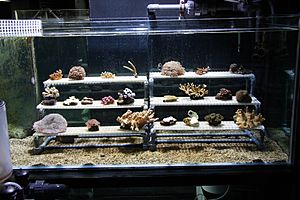Fragmentation (reproduction) facts for kids
In biology, fragmentation is a cool way some living things make copies of themselves. It happens when an organism's body breaks into two or more pieces. Each of these pieces can then grow into a brand new, complete individual!
Think of it like this: if you break a cookie into pieces, you still have cookie pieces. But with fragmentation, if a special organism breaks, each piece can become a whole new organism! This is a type of asexual reproduction. It means the new individuals are exact copies, or clones, of the original.
Sometimes, the splitting happens on purpose. The organism might have special parts that can easily break off. Other times, it might happen by accident, like from an injury. For this to work as reproduction, each broken piece must be able to grow back all the missing parts.
Many different organisms use fragmentation to reproduce. This includes some types of algae, molds, lichens, and many plants. You can also see it in animals like sponges, worms, and sea stars.
Contents
How Organisms Reproduce by Fragmentation
Fragmentation is a very common way for many simple organisms to create new life. It's a natural process that helps them spread and grow.
Fragmentation in Fungi
Fungi include things like molds, yeasts, and mushrooms. Many fungi grow tiny threads called hyphae. These hyphae help the fungus get food.
When a piece of these hyphae breaks off, it can start growing on its own. This single piece can then develop into a whole new fungus! It's a simple and effective way for fungi to spread.
Fragmentation in Lichens
Lichens are interesting organisms. They are actually a mix of a fungus and an algae living together. Many lichens have special parts that can easily break away.
These tiny pieces contain both the fungus and the algae. When they break off, they can be carried by wind or water. If they land in a good spot, they can grow into a new lichen. Larger pieces of a lichen can also break off and start new colonies.
Fragmentation in Plants
Fragmentation is a super common way for plants to reproduce without seeds. This is called vegetative reproduction. Many trees, shrubs, and ferns can form large groups of identical plants.
They do this by sending out special stems that grow underground, called rhizomes, or above ground, called stolons. These stems can grow new roots and shoots. If a new shoot gets separated from the main plant, it becomes a new, independent plant.
People also use fragmentation to grow many plants. This is called plant propagation. For example, you can take a cutting from a plant. If you plant this cutting, it can grow roots and become a new plant. Other methods include layering and using parts like bulbs or tubers.
Fragmentation in Animals
Some animals also use fragmentation to reproduce. Sponges and coral colonies are good examples. They can naturally break into pieces, and each piece can grow into a new colony.
Many types of annelid worms and flatworms also reproduce this way. If one of these worms is cut or breaks apart, each section can often regenerate. This means each piece can grow back the missing parts and become a complete worm.
See also
 In Spanish: Fragmentación (reproducción) para niños
In Spanish: Fragmentación (reproducción) para niños


